Financial and Management Accounting Report: Stephenson Ltd Analysis
VerifiedAdded on 2022/12/19
|11
|2570
|90
Report
AI Summary
This report provides a comprehensive financial analysis of Stephenson Ltd, examining its financial performance over two years. It begins by calculating gross and net profits, along with relevant ratios, to assess profitability trends. The report then delves into the reasons behind declining profits and cash flow issues, followed by recommendations for strategic improvements. Break-even and cost-volume-profit analyses are performed for 'The Climbing Cat' to determine profitable sales targets. The report further explores the advantages and disadvantages of Activity Based Costing. Finally, it analyzes variances between projected and actual figures, projecting their business consequences, and suggesting strategies for variance elimination or correction. The report concludes with an evaluation of the advantages and disadvantages of switching from Incremental Based Budgeting to Zero Based Budgeting.
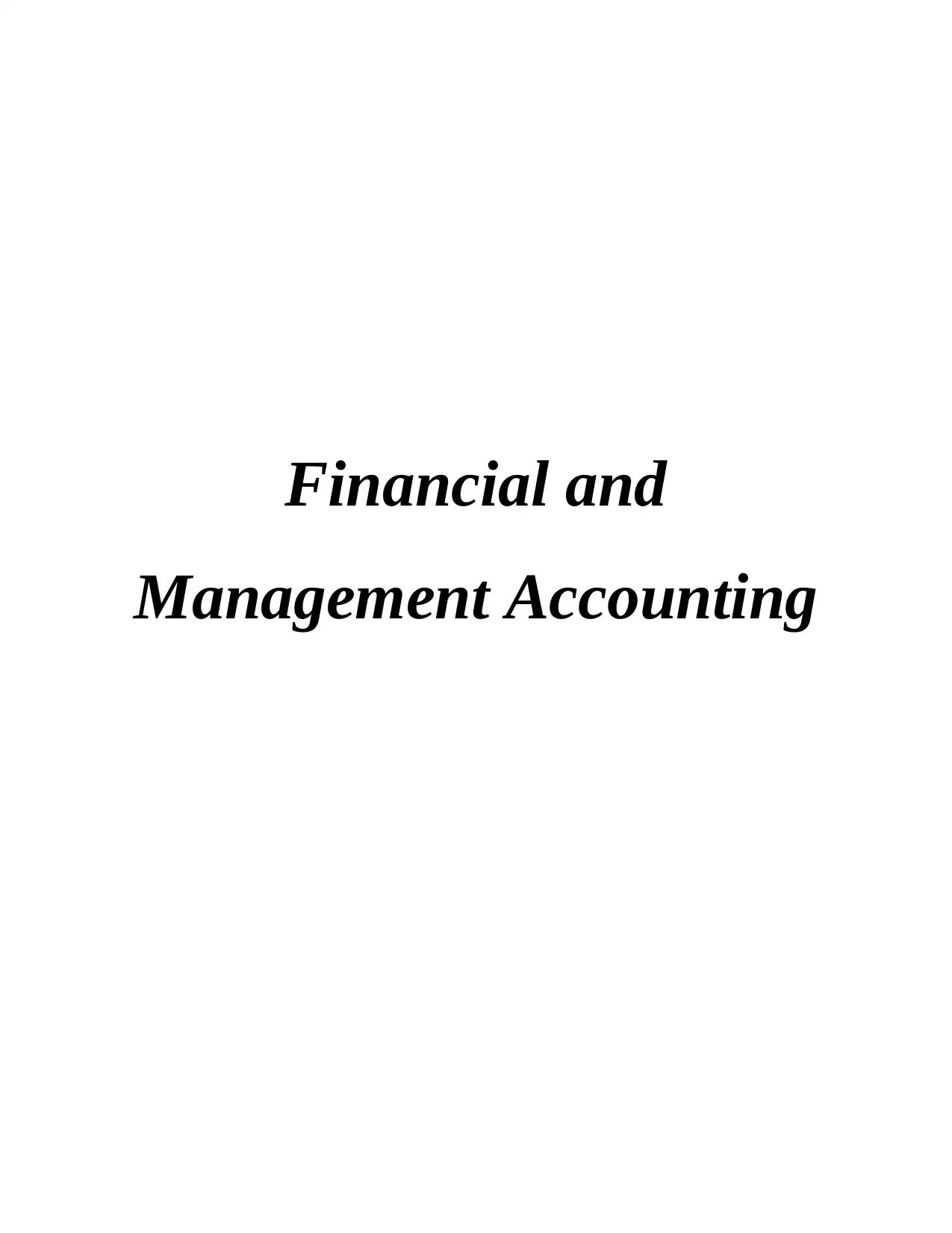
Financial and
Management Accounting
Management Accounting
Paraphrase This Document
Need a fresh take? Get an instant paraphrase of this document with our AI Paraphraser
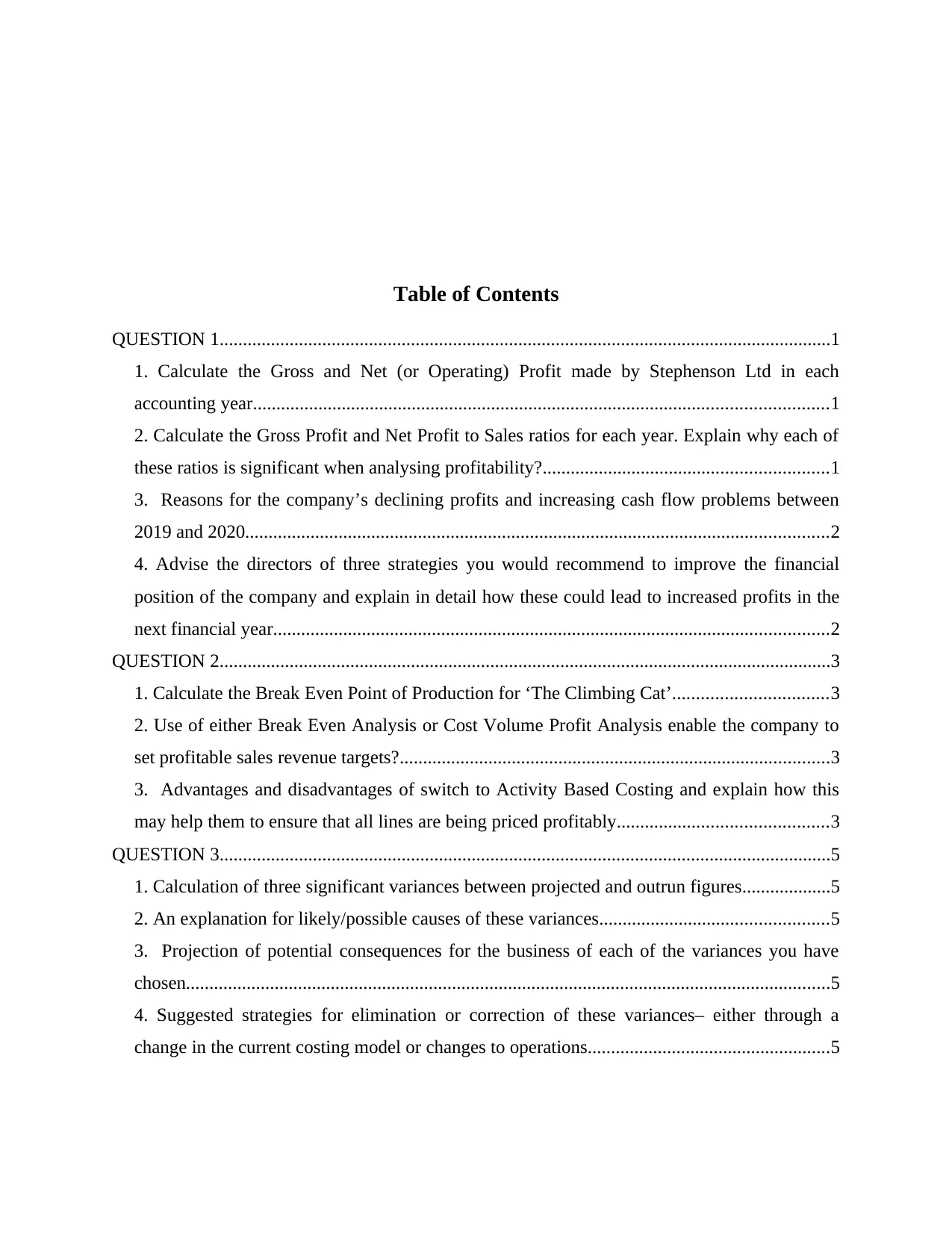
Table of Contents
QUESTION 1...................................................................................................................................1
1. Calculate the Gross and Net (or Operating) Profit made by Stephenson Ltd in each
accounting year...........................................................................................................................1
2. Calculate the Gross Profit and Net Profit to Sales ratios for each year. Explain why each of
these ratios is significant when analysing profitability?.............................................................1
3. Reasons for the company’s declining profits and increasing cash flow problems between
2019 and 2020.............................................................................................................................2
4. Advise the directors of three strategies you would recommend to improve the financial
position of the company and explain in detail how these could lead to increased profits in the
next financial year.......................................................................................................................2
QUESTION 2...................................................................................................................................3
1. Calculate the Break Even Point of Production for ‘The Climbing Cat’.................................3
2. Use of either Break Even Analysis or Cost Volume Profit Analysis enable the company to
set profitable sales revenue targets?............................................................................................3
3. Advantages and disadvantages of switch to Activity Based Costing and explain how this
may help them to ensure that all lines are being priced profitably.............................................3
QUESTION 3...................................................................................................................................5
1. Calculation of three significant variances between projected and outrun figures...................5
2. An explanation for likely/possible causes of these variances.................................................5
3. Projection of potential consequences for the business of each of the variances you have
chosen..........................................................................................................................................5
4. Suggested strategies for elimination or correction of these variances– either through a
change in the current costing model or changes to operations....................................................5
QUESTION 1...................................................................................................................................1
1. Calculate the Gross and Net (or Operating) Profit made by Stephenson Ltd in each
accounting year...........................................................................................................................1
2. Calculate the Gross Profit and Net Profit to Sales ratios for each year. Explain why each of
these ratios is significant when analysing profitability?.............................................................1
3. Reasons for the company’s declining profits and increasing cash flow problems between
2019 and 2020.............................................................................................................................2
4. Advise the directors of three strategies you would recommend to improve the financial
position of the company and explain in detail how these could lead to increased profits in the
next financial year.......................................................................................................................2
QUESTION 2...................................................................................................................................3
1. Calculate the Break Even Point of Production for ‘The Climbing Cat’.................................3
2. Use of either Break Even Analysis or Cost Volume Profit Analysis enable the company to
set profitable sales revenue targets?............................................................................................3
3. Advantages and disadvantages of switch to Activity Based Costing and explain how this
may help them to ensure that all lines are being priced profitably.............................................3
QUESTION 3...................................................................................................................................5
1. Calculation of three significant variances between projected and outrun figures...................5
2. An explanation for likely/possible causes of these variances.................................................5
3. Projection of potential consequences for the business of each of the variances you have
chosen..........................................................................................................................................5
4. Suggested strategies for elimination or correction of these variances– either through a
change in the current costing model or changes to operations....................................................5

5. Evaluation of the advantages disadvantages of a switch from Incremental Based Budgeting
to Zero Based Budgeting.............................................................................................................6
REFERENCES................................................................................................................................8
to Zero Based Budgeting.............................................................................................................6
REFERENCES................................................................................................................................8
⊘ This is a preview!⊘
Do you want full access?
Subscribe today to unlock all pages.

Trusted by 1+ million students worldwide
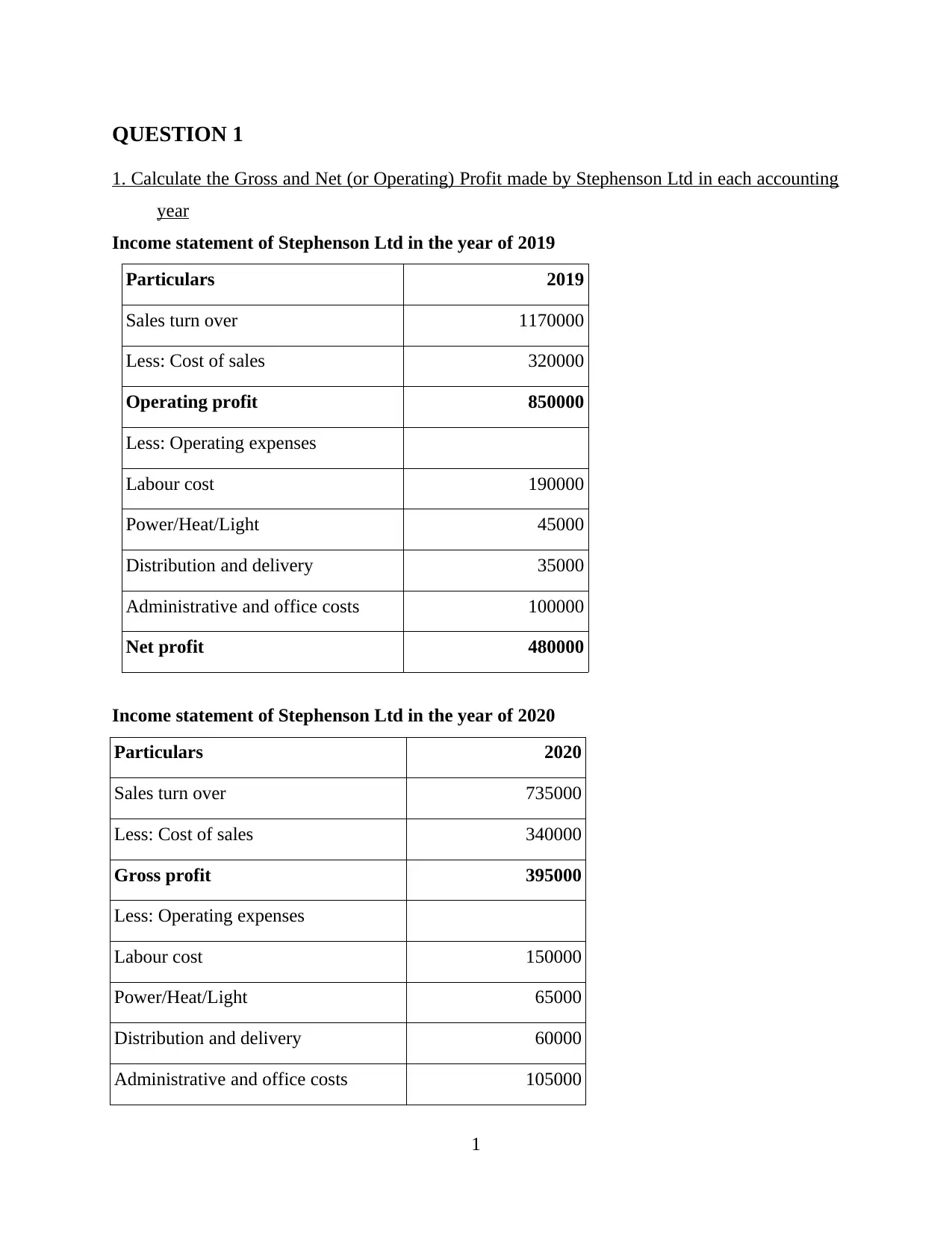
QUESTION 1
1. Calculate the Gross and Net (or Operating) Profit made by Stephenson Ltd in each accounting
year
Income statement of Stephenson Ltd in the year of 2019
Particulars 2019
Sales turn over 1170000
Less: Cost of sales 320000
Operating profit 850000
Less: Operating expenses
Labour cost 190000
Power/Heat/Light 45000
Distribution and delivery 35000
Administrative and office costs 100000
Net profit 480000
Income statement of Stephenson Ltd in the year of 2020
Particulars 2020
Sales turn over 735000
Less: Cost of sales 340000
Gross profit 395000
Less: Operating expenses
Labour cost 150000
Power/Heat/Light 65000
Distribution and delivery 60000
Administrative and office costs 105000
1
1. Calculate the Gross and Net (or Operating) Profit made by Stephenson Ltd in each accounting
year
Income statement of Stephenson Ltd in the year of 2019
Particulars 2019
Sales turn over 1170000
Less: Cost of sales 320000
Operating profit 850000
Less: Operating expenses
Labour cost 190000
Power/Heat/Light 45000
Distribution and delivery 35000
Administrative and office costs 100000
Net profit 480000
Income statement of Stephenson Ltd in the year of 2020
Particulars 2020
Sales turn over 735000
Less: Cost of sales 340000
Gross profit 395000
Less: Operating expenses
Labour cost 150000
Power/Heat/Light 65000
Distribution and delivery 60000
Administrative and office costs 105000
1
Paraphrase This Document
Need a fresh take? Get an instant paraphrase of this document with our AI Paraphraser
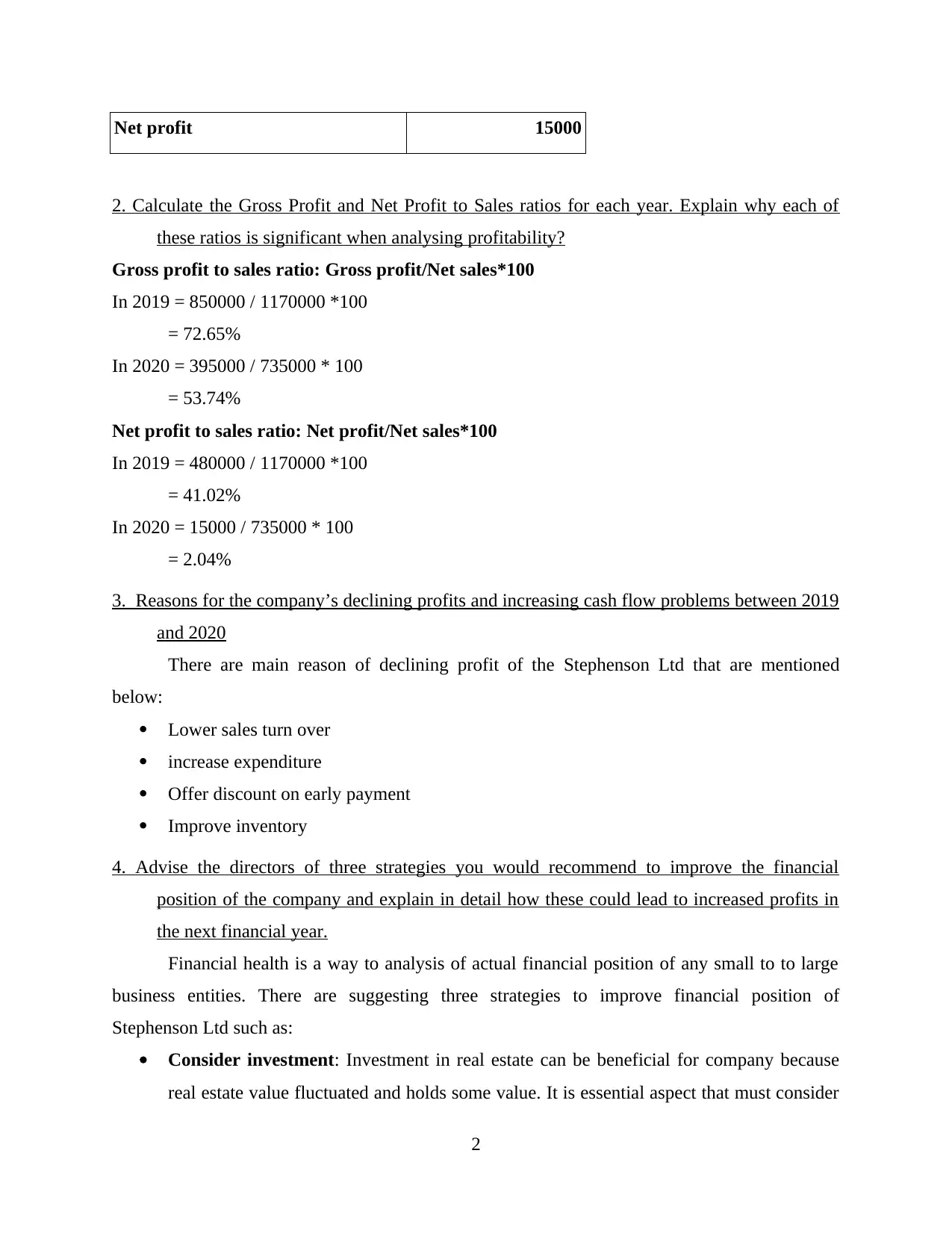
Net profit 15000
2. Calculate the Gross Profit and Net Profit to Sales ratios for each year. Explain why each of
these ratios is significant when analysing profitability?
Gross profit to sales ratio: Gross profit/Net sales*100
In 2019 = 850000 / 1170000 *100
= 72.65%
In 2020 = 395000 / 735000 * 100
= 53.74%
Net profit to sales ratio: Net profit/Net sales*100
In 2019 = 480000 / 1170000 *100
= 41.02%
In 2020 = 15000 / 735000 * 100
= 2.04%
3. Reasons for the company’s declining profits and increasing cash flow problems between 2019
and 2020
There are main reason of declining profit of the Stephenson Ltd that are mentioned
below:
Lower sales turn over
increase expenditure
Offer discount on early payment
Improve inventory
4. Advise the directors of three strategies you would recommend to improve the financial
position of the company and explain in detail how these could lead to increased profits in
the next financial year.
Financial health is a way to analysis of actual financial position of any small to to large
business entities. There are suggesting three strategies to improve financial position of
Stephenson Ltd such as:
Consider investment: Investment in real estate can be beneficial for company because
real estate value fluctuated and holds some value. It is essential aspect that must consider
2
2. Calculate the Gross Profit and Net Profit to Sales ratios for each year. Explain why each of
these ratios is significant when analysing profitability?
Gross profit to sales ratio: Gross profit/Net sales*100
In 2019 = 850000 / 1170000 *100
= 72.65%
In 2020 = 395000 / 735000 * 100
= 53.74%
Net profit to sales ratio: Net profit/Net sales*100
In 2019 = 480000 / 1170000 *100
= 41.02%
In 2020 = 15000 / 735000 * 100
= 2.04%
3. Reasons for the company’s declining profits and increasing cash flow problems between 2019
and 2020
There are main reason of declining profit of the Stephenson Ltd that are mentioned
below:
Lower sales turn over
increase expenditure
Offer discount on early payment
Improve inventory
4. Advise the directors of three strategies you would recommend to improve the financial
position of the company and explain in detail how these could lead to increased profits in
the next financial year.
Financial health is a way to analysis of actual financial position of any small to to large
business entities. There are suggesting three strategies to improve financial position of
Stephenson Ltd such as:
Consider investment: Investment in real estate can be beneficial for company because
real estate value fluctuated and holds some value. It is essential aspect that must consider
2
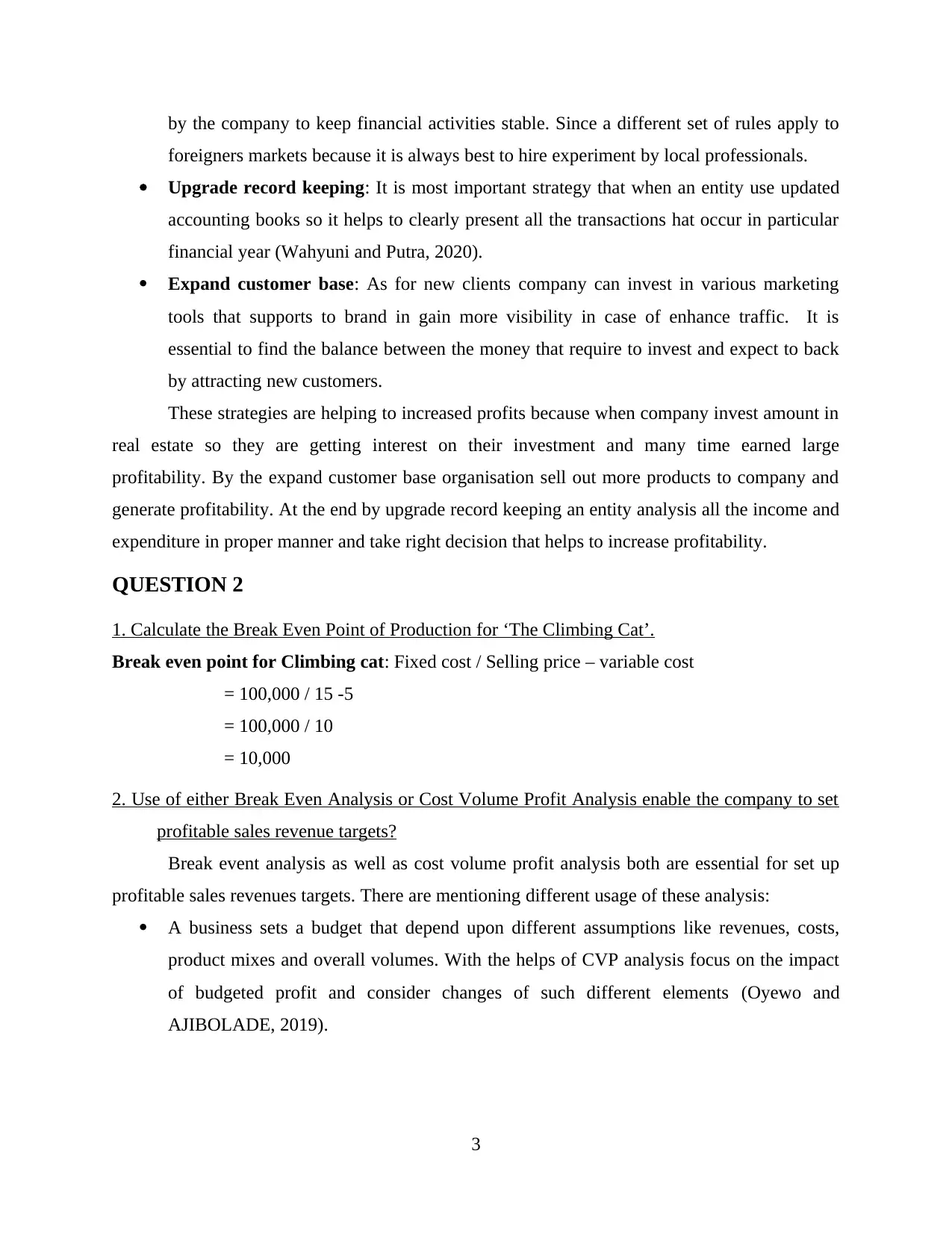
by the company to keep financial activities stable. Since a different set of rules apply to
foreigners markets because it is always best to hire experiment by local professionals.
Upgrade record keeping: It is most important strategy that when an entity use updated
accounting books so it helps to clearly present all the transactions hat occur in particular
financial year (Wahyuni and Putra, 2020).
Expand customer base: As for new clients company can invest in various marketing
tools that supports to brand in gain more visibility in case of enhance traffic. It is
essential to find the balance between the money that require to invest and expect to back
by attracting new customers.
These strategies are helping to increased profits because when company invest amount in
real estate so they are getting interest on their investment and many time earned large
profitability. By the expand customer base organisation sell out more products to company and
generate profitability. At the end by upgrade record keeping an entity analysis all the income and
expenditure in proper manner and take right decision that helps to increase profitability.
QUESTION 2
1. Calculate the Break Even Point of Production for ‘The Climbing Cat’.
Break even point for Climbing cat: Fixed cost / Selling price – variable cost
= 100,000 / 15 -5
= 100,000 / 10
= 10,000
2. Use of either Break Even Analysis or Cost Volume Profit Analysis enable the company to set
profitable sales revenue targets?
Break event analysis as well as cost volume profit analysis both are essential for set up
profitable sales revenues targets. There are mentioning different usage of these analysis:
A business sets a budget that depend upon different assumptions like revenues, costs,
product mixes and overall volumes. With the helps of CVP analysis focus on the impact
of budgeted profit and consider changes of such different elements (Oyewo and
AJIBOLADE, 2019).
3
foreigners markets because it is always best to hire experiment by local professionals.
Upgrade record keeping: It is most important strategy that when an entity use updated
accounting books so it helps to clearly present all the transactions hat occur in particular
financial year (Wahyuni and Putra, 2020).
Expand customer base: As for new clients company can invest in various marketing
tools that supports to brand in gain more visibility in case of enhance traffic. It is
essential to find the balance between the money that require to invest and expect to back
by attracting new customers.
These strategies are helping to increased profits because when company invest amount in
real estate so they are getting interest on their investment and many time earned large
profitability. By the expand customer base organisation sell out more products to company and
generate profitability. At the end by upgrade record keeping an entity analysis all the income and
expenditure in proper manner and take right decision that helps to increase profitability.
QUESTION 2
1. Calculate the Break Even Point of Production for ‘The Climbing Cat’.
Break even point for Climbing cat: Fixed cost / Selling price – variable cost
= 100,000 / 15 -5
= 100,000 / 10
= 10,000
2. Use of either Break Even Analysis or Cost Volume Profit Analysis enable the company to set
profitable sales revenue targets?
Break event analysis as well as cost volume profit analysis both are essential for set up
profitable sales revenues targets. There are mentioning different usage of these analysis:
A business sets a budget that depend upon different assumptions like revenues, costs,
product mixes and overall volumes. With the helps of CVP analysis focus on the impact
of budgeted profit and consider changes of such different elements (Oyewo and
AJIBOLADE, 2019).
3
⊘ This is a preview!⊘
Do you want full access?
Subscribe today to unlock all pages.

Trusted by 1+ million students worldwide
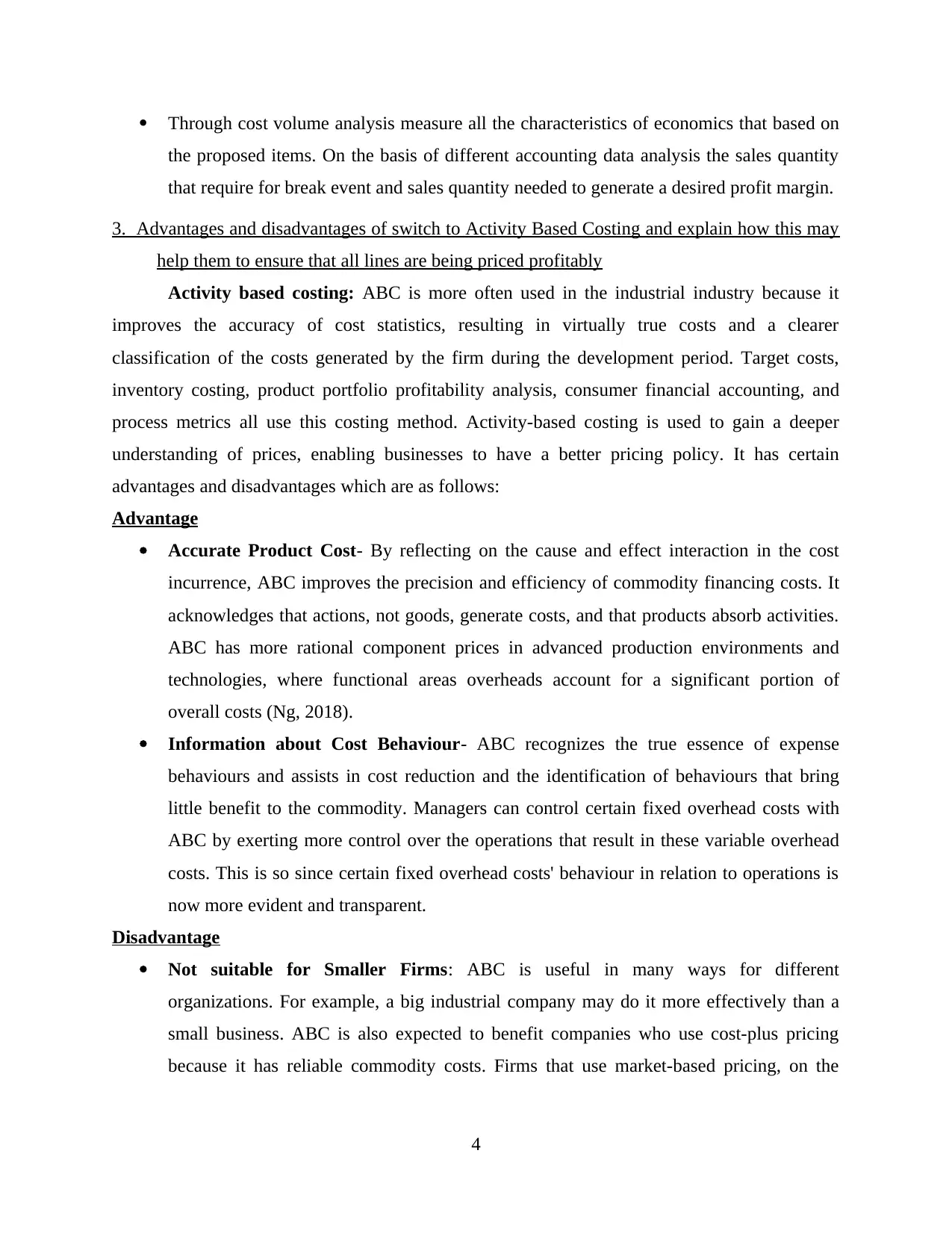
Through cost volume analysis measure all the characteristics of economics that based on
the proposed items. On the basis of different accounting data analysis the sales quantity
that require for break event and sales quantity needed to generate a desired profit margin.
3. Advantages and disadvantages of switch to Activity Based Costing and explain how this may
help them to ensure that all lines are being priced profitably
Activity based costing: ABC is more often used in the industrial industry because it
improves the accuracy of cost statistics, resulting in virtually true costs and a clearer
classification of the costs generated by the firm during the development period. Target costs,
inventory costing, product portfolio profitability analysis, consumer financial accounting, and
process metrics all use this costing method. Activity-based costing is used to gain a deeper
understanding of prices, enabling businesses to have a better pricing policy. It has certain
advantages and disadvantages which are as follows:
Advantage
Accurate Product Cost- By reflecting on the cause and effect interaction in the cost
incurrence, ABC improves the precision and efficiency of commodity financing costs. It
acknowledges that actions, not goods, generate costs, and that products absorb activities.
ABC has more rational component prices in advanced production environments and
technologies, where functional areas overheads account for a significant portion of
overall costs (Ng, 2018).
Information about Cost Behaviour- ABC recognizes the true essence of expense
behaviours and assists in cost reduction and the identification of behaviours that bring
little benefit to the commodity. Managers can control certain fixed overhead costs with
ABC by exerting more control over the operations that result in these variable overhead
costs. This is so since certain fixed overhead costs' behaviour in relation to operations is
now more evident and transparent.
Disadvantage
Not suitable for Smaller Firms: ABC is useful in many ways for different
organizations. For example, a big industrial company may do it more effectively than a
small business. ABC is also expected to benefit companies who use cost-plus pricing
because it has reliable commodity costs. Firms that use market-based pricing, on the
4
the proposed items. On the basis of different accounting data analysis the sales quantity
that require for break event and sales quantity needed to generate a desired profit margin.
3. Advantages and disadvantages of switch to Activity Based Costing and explain how this may
help them to ensure that all lines are being priced profitably
Activity based costing: ABC is more often used in the industrial industry because it
improves the accuracy of cost statistics, resulting in virtually true costs and a clearer
classification of the costs generated by the firm during the development period. Target costs,
inventory costing, product portfolio profitability analysis, consumer financial accounting, and
process metrics all use this costing method. Activity-based costing is used to gain a deeper
understanding of prices, enabling businesses to have a better pricing policy. It has certain
advantages and disadvantages which are as follows:
Advantage
Accurate Product Cost- By reflecting on the cause and effect interaction in the cost
incurrence, ABC improves the precision and efficiency of commodity financing costs. It
acknowledges that actions, not goods, generate costs, and that products absorb activities.
ABC has more rational component prices in advanced production environments and
technologies, where functional areas overheads account for a significant portion of
overall costs (Ng, 2018).
Information about Cost Behaviour- ABC recognizes the true essence of expense
behaviours and assists in cost reduction and the identification of behaviours that bring
little benefit to the commodity. Managers can control certain fixed overhead costs with
ABC by exerting more control over the operations that result in these variable overhead
costs. This is so since certain fixed overhead costs' behaviour in relation to operations is
now more evident and transparent.
Disadvantage
Not suitable for Smaller Firms: ABC is useful in many ways for different
organizations. For example, a big industrial company may do it more effectively than a
small business. ABC is also expected to benefit companies who use cost-plus pricing
because it has reliable commodity costs. Firms that use market-based pricing, on the
4
Paraphrase This Document
Need a fresh take? Get an instant paraphrase of this document with our AI Paraphraser
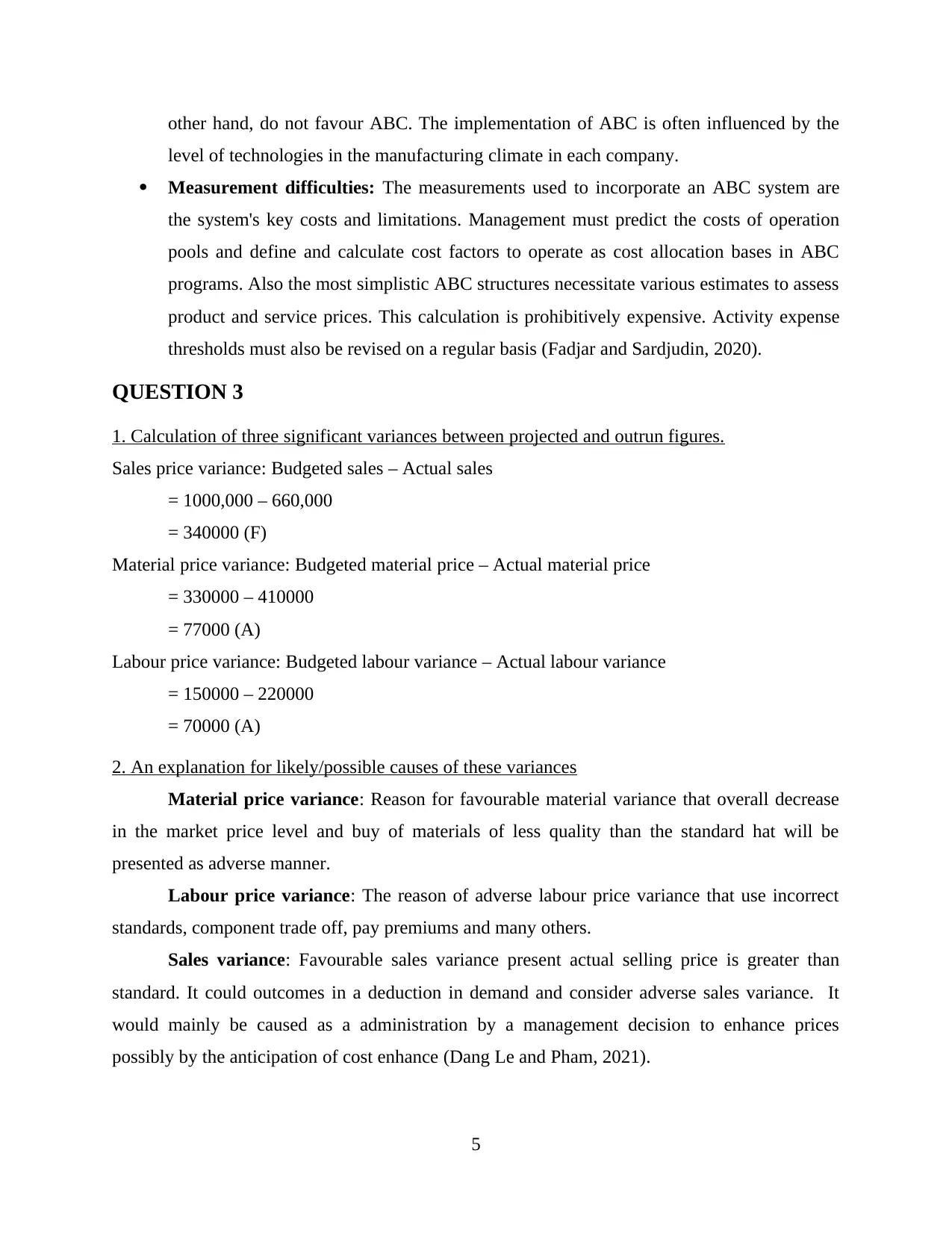
other hand, do not favour ABC. The implementation of ABC is often influenced by the
level of technologies in the manufacturing climate in each company.
Measurement difficulties: The measurements used to incorporate an ABC system are
the system's key costs and limitations. Management must predict the costs of operation
pools and define and calculate cost factors to operate as cost allocation bases in ABC
programs. Also the most simplistic ABC structures necessitate various estimates to assess
product and service prices. This calculation is prohibitively expensive. Activity expense
thresholds must also be revised on a regular basis (Fadjar and Sardjudin, 2020).
QUESTION 3
1. Calculation of three significant variances between projected and outrun figures.
Sales price variance: Budgeted sales – Actual sales
= 1000,000 – 660,000
= 340000 (F)
Material price variance: Budgeted material price – Actual material price
= 330000 – 410000
= 77000 (A)
Labour price variance: Budgeted labour variance – Actual labour variance
= 150000 – 220000
= 70000 (A)
2. An explanation for likely/possible causes of these variances
Material price variance: Reason for favourable material variance that overall decrease
in the market price level and buy of materials of less quality than the standard hat will be
presented as adverse manner.
Labour price variance: The reason of adverse labour price variance that use incorrect
standards, component trade off, pay premiums and many others.
Sales variance: Favourable sales variance present actual selling price is greater than
standard. It could outcomes in a deduction in demand and consider adverse sales variance. It
would mainly be caused as a administration by a management decision to enhance prices
possibly by the anticipation of cost enhance (Dang Le and Pham, 2021).
5
level of technologies in the manufacturing climate in each company.
Measurement difficulties: The measurements used to incorporate an ABC system are
the system's key costs and limitations. Management must predict the costs of operation
pools and define and calculate cost factors to operate as cost allocation bases in ABC
programs. Also the most simplistic ABC structures necessitate various estimates to assess
product and service prices. This calculation is prohibitively expensive. Activity expense
thresholds must also be revised on a regular basis (Fadjar and Sardjudin, 2020).
QUESTION 3
1. Calculation of three significant variances between projected and outrun figures.
Sales price variance: Budgeted sales – Actual sales
= 1000,000 – 660,000
= 340000 (F)
Material price variance: Budgeted material price – Actual material price
= 330000 – 410000
= 77000 (A)
Labour price variance: Budgeted labour variance – Actual labour variance
= 150000 – 220000
= 70000 (A)
2. An explanation for likely/possible causes of these variances
Material price variance: Reason for favourable material variance that overall decrease
in the market price level and buy of materials of less quality than the standard hat will be
presented as adverse manner.
Labour price variance: The reason of adverse labour price variance that use incorrect
standards, component trade off, pay premiums and many others.
Sales variance: Favourable sales variance present actual selling price is greater than
standard. It could outcomes in a deduction in demand and consider adverse sales variance. It
would mainly be caused as a administration by a management decision to enhance prices
possibly by the anticipation of cost enhance (Dang Le and Pham, 2021).
5
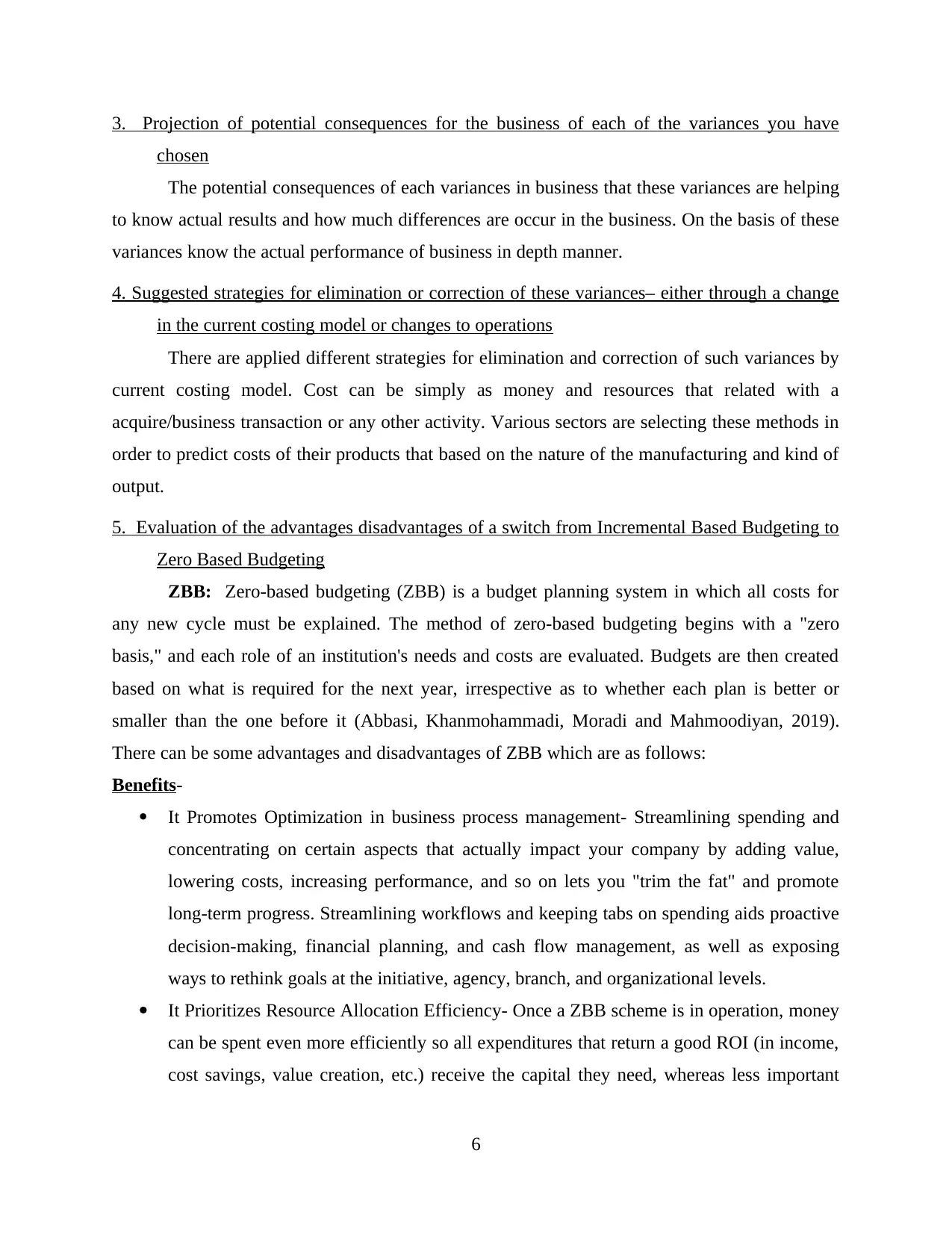
3. Projection of potential consequences for the business of each of the variances you have
chosen
The potential consequences of each variances in business that these variances are helping
to know actual results and how much differences are occur in the business. On the basis of these
variances know the actual performance of business in depth manner.
4. Suggested strategies for elimination or correction of these variances– either through a change
in the current costing model or changes to operations
There are applied different strategies for elimination and correction of such variances by
current costing model. Cost can be simply as money and resources that related with a
acquire/business transaction or any other activity. Various sectors are selecting these methods in
order to predict costs of their products that based on the nature of the manufacturing and kind of
output.
5. Evaluation of the advantages disadvantages of a switch from Incremental Based Budgeting to
Zero Based Budgeting
ZBB: Zero-based budgeting (ZBB) is a budget planning system in which all costs for
any new cycle must be explained. The method of zero-based budgeting begins with a "zero
basis," and each role of an institution's needs and costs are evaluated. Budgets are then created
based on what is required for the next year, irrespective as to whether each plan is better or
smaller than the one before it (Abbasi, Khanmohammadi, Moradi and Mahmoodiyan, 2019).
There can be some advantages and disadvantages of ZBB which are as follows:
Benefits-
It Promotes Optimization in business process management- Streamlining spending and
concentrating on certain aspects that actually impact your company by adding value,
lowering costs, increasing performance, and so on lets you "trim the fat" and promote
long-term progress. Streamlining workflows and keeping tabs on spending aids proactive
decision-making, financial planning, and cash flow management, as well as exposing
ways to rethink goals at the initiative, agency, branch, and organizational levels.
It Prioritizes Resource Allocation Efficiency- Once a ZBB scheme is in operation, money
can be spent even more efficiently so all expenditures that return a good ROI (in income,
cost savings, value creation, etc.) receive the capital they need, whereas less important
6
chosen
The potential consequences of each variances in business that these variances are helping
to know actual results and how much differences are occur in the business. On the basis of these
variances know the actual performance of business in depth manner.
4. Suggested strategies for elimination or correction of these variances– either through a change
in the current costing model or changes to operations
There are applied different strategies for elimination and correction of such variances by
current costing model. Cost can be simply as money and resources that related with a
acquire/business transaction or any other activity. Various sectors are selecting these methods in
order to predict costs of their products that based on the nature of the manufacturing and kind of
output.
5. Evaluation of the advantages disadvantages of a switch from Incremental Based Budgeting to
Zero Based Budgeting
ZBB: Zero-based budgeting (ZBB) is a budget planning system in which all costs for
any new cycle must be explained. The method of zero-based budgeting begins with a "zero
basis," and each role of an institution's needs and costs are evaluated. Budgets are then created
based on what is required for the next year, irrespective as to whether each plan is better or
smaller than the one before it (Abbasi, Khanmohammadi, Moradi and Mahmoodiyan, 2019).
There can be some advantages and disadvantages of ZBB which are as follows:
Benefits-
It Promotes Optimization in business process management- Streamlining spending and
concentrating on certain aspects that actually impact your company by adding value,
lowering costs, increasing performance, and so on lets you "trim the fat" and promote
long-term progress. Streamlining workflows and keeping tabs on spending aids proactive
decision-making, financial planning, and cash flow management, as well as exposing
ways to rethink goals at the initiative, agency, branch, and organizational levels.
It Prioritizes Resource Allocation Efficiency- Once a ZBB scheme is in operation, money
can be spent even more efficiently so all expenditures that return a good ROI (in income,
cost savings, value creation, etc.) receive the capital they need, whereas less important
6
⊘ This is a preview!⊘
Do you want full access?
Subscribe today to unlock all pages.

Trusted by 1+ million students worldwide
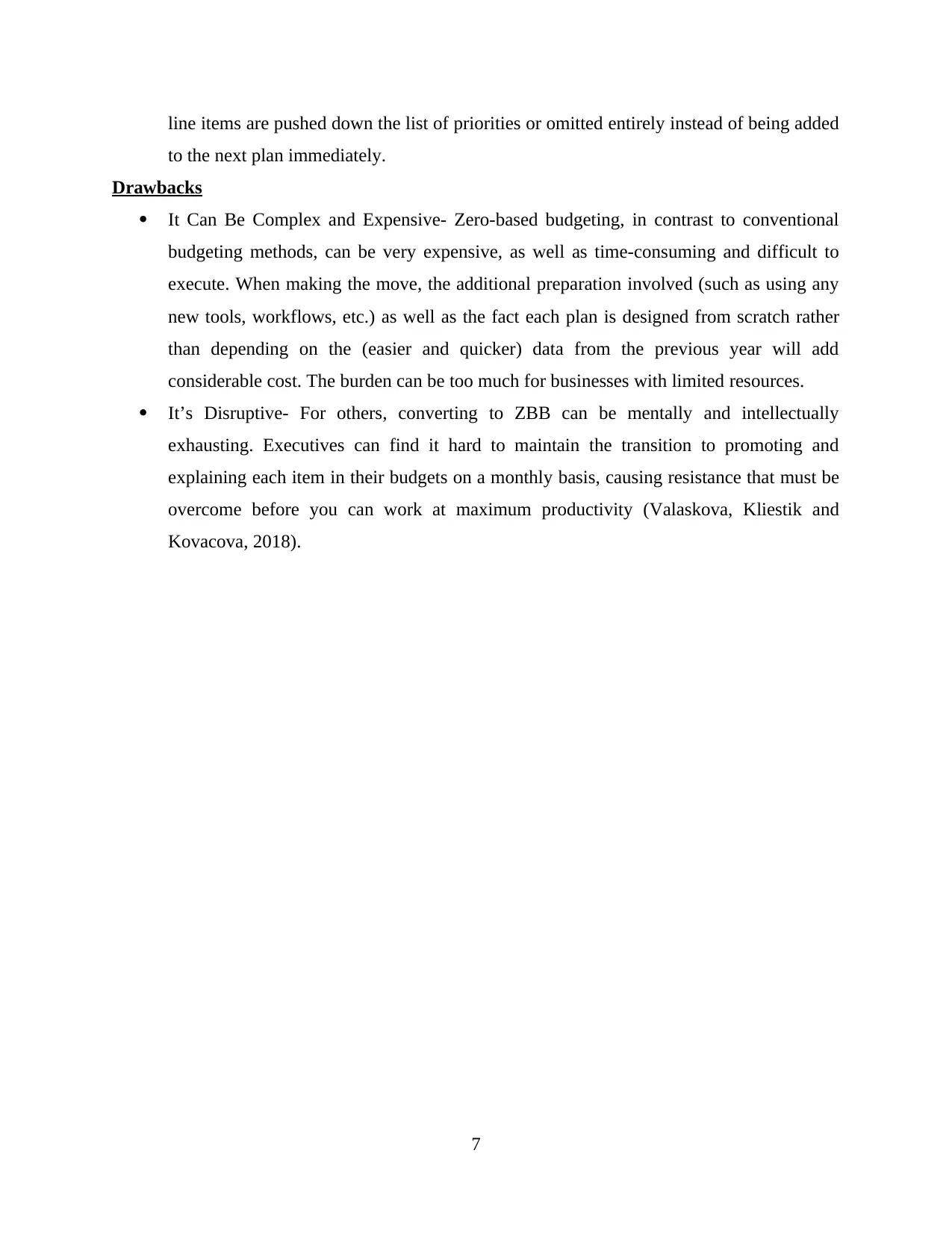
line items are pushed down the list of priorities or omitted entirely instead of being added
to the next plan immediately.
Drawbacks
It Can Be Complex and Expensive- Zero-based budgeting, in contrast to conventional
budgeting methods, can be very expensive, as well as time-consuming and difficult to
execute. When making the move, the additional preparation involved (such as using any
new tools, workflows, etc.) as well as the fact each plan is designed from scratch rather
than depending on the (easier and quicker) data from the previous year will add
considerable cost. The burden can be too much for businesses with limited resources.
It’s Disruptive- For others, converting to ZBB can be mentally and intellectually
exhausting. Executives can find it hard to maintain the transition to promoting and
explaining each item in their budgets on a monthly basis, causing resistance that must be
overcome before you can work at maximum productivity (Valaskova, Kliestik and
Kovacova, 2018).
7
to the next plan immediately.
Drawbacks
It Can Be Complex and Expensive- Zero-based budgeting, in contrast to conventional
budgeting methods, can be very expensive, as well as time-consuming and difficult to
execute. When making the move, the additional preparation involved (such as using any
new tools, workflows, etc.) as well as the fact each plan is designed from scratch rather
than depending on the (easier and quicker) data from the previous year will add
considerable cost. The burden can be too much for businesses with limited resources.
It’s Disruptive- For others, converting to ZBB can be mentally and intellectually
exhausting. Executives can find it hard to maintain the transition to promoting and
explaining each item in their budgets on a monthly basis, causing resistance that must be
overcome before you can work at maximum productivity (Valaskova, Kliestik and
Kovacova, 2018).
7
Paraphrase This Document
Need a fresh take? Get an instant paraphrase of this document with our AI Paraphraser
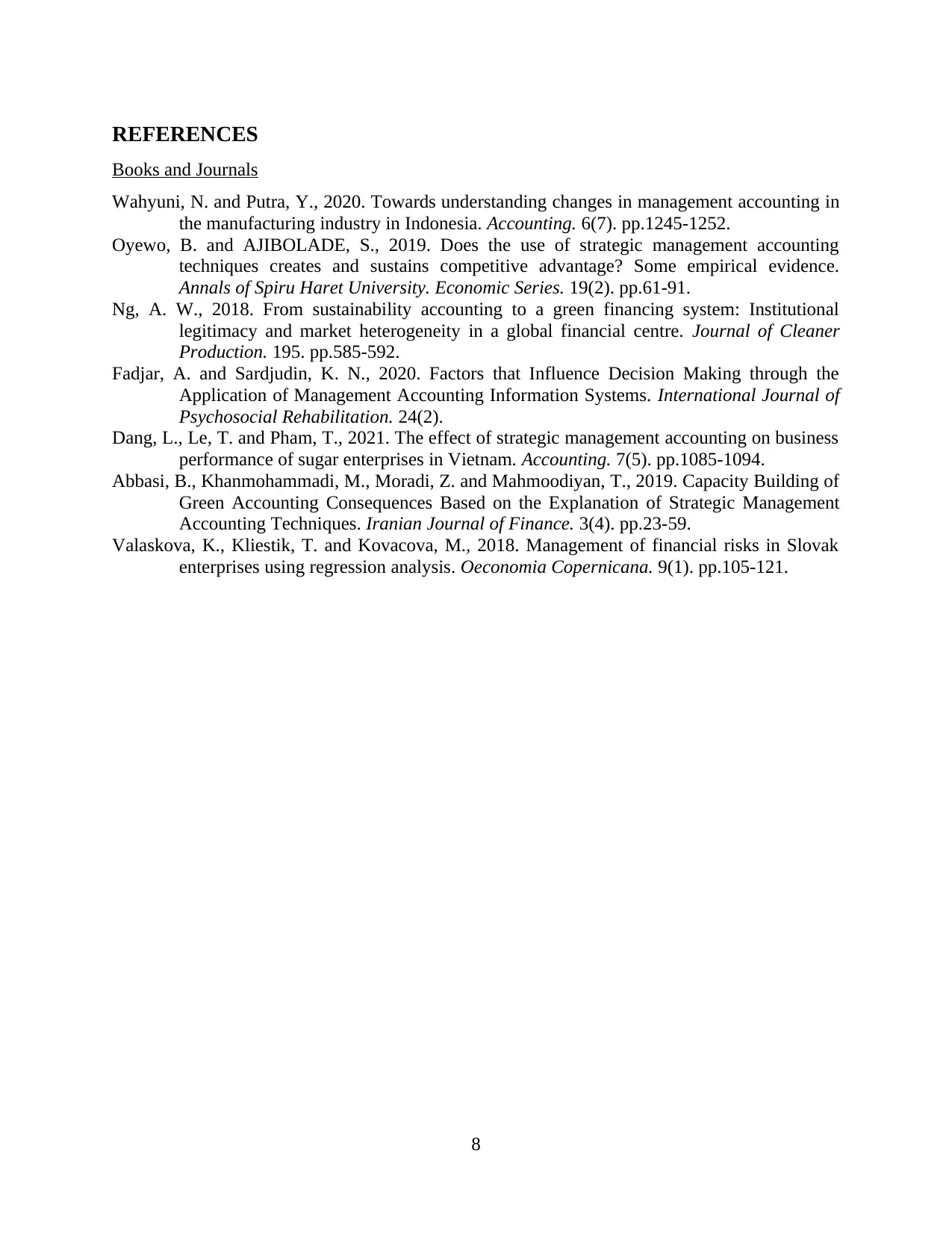
REFERENCES
Books and Journals
Wahyuni, N. and Putra, Y., 2020. Towards understanding changes in management accounting in
the manufacturing industry in Indonesia. Accounting. 6(7). pp.1245-1252.
Oyewo, B. and AJIBOLADE, S., 2019. Does the use of strategic management accounting
techniques creates and sustains competitive advantage? Some empirical evidence.
Annals of Spiru Haret University. Economic Series. 19(2). pp.61-91.
Ng, A. W., 2018. From sustainability accounting to a green financing system: Institutional
legitimacy and market heterogeneity in a global financial centre. Journal of Cleaner
Production. 195. pp.585-592.
Fadjar, A. and Sardjudin, K. N., 2020. Factors that Influence Decision Making through the
Application of Management Accounting Information Systems. International Journal of
Psychosocial Rehabilitation. 24(2).
Dang, L., Le, T. and Pham, T., 2021. The effect of strategic management accounting on business
performance of sugar enterprises in Vietnam. Accounting. 7(5). pp.1085-1094.
Abbasi, B., Khanmohammadi, M., Moradi, Z. and Mahmoodiyan, T., 2019. Capacity Building of
Green Accounting Consequences Based on the Explanation of Strategic Management
Accounting Techniques. Iranian Journal of Finance. 3(4). pp.23-59.
Valaskova, K., Kliestik, T. and Kovacova, M., 2018. Management of financial risks in Slovak
enterprises using regression analysis. Oeconomia Copernicana. 9(1). pp.105-121.
8
Books and Journals
Wahyuni, N. and Putra, Y., 2020. Towards understanding changes in management accounting in
the manufacturing industry in Indonesia. Accounting. 6(7). pp.1245-1252.
Oyewo, B. and AJIBOLADE, S., 2019. Does the use of strategic management accounting
techniques creates and sustains competitive advantage? Some empirical evidence.
Annals of Spiru Haret University. Economic Series. 19(2). pp.61-91.
Ng, A. W., 2018. From sustainability accounting to a green financing system: Institutional
legitimacy and market heterogeneity in a global financial centre. Journal of Cleaner
Production. 195. pp.585-592.
Fadjar, A. and Sardjudin, K. N., 2020. Factors that Influence Decision Making through the
Application of Management Accounting Information Systems. International Journal of
Psychosocial Rehabilitation. 24(2).
Dang, L., Le, T. and Pham, T., 2021. The effect of strategic management accounting on business
performance of sugar enterprises in Vietnam. Accounting. 7(5). pp.1085-1094.
Abbasi, B., Khanmohammadi, M., Moradi, Z. and Mahmoodiyan, T., 2019. Capacity Building of
Green Accounting Consequences Based on the Explanation of Strategic Management
Accounting Techniques. Iranian Journal of Finance. 3(4). pp.23-59.
Valaskova, K., Kliestik, T. and Kovacova, M., 2018. Management of financial risks in Slovak
enterprises using regression analysis. Oeconomia Copernicana. 9(1). pp.105-121.
8
1 out of 11
Related Documents
Your All-in-One AI-Powered Toolkit for Academic Success.
+13062052269
info@desklib.com
Available 24*7 on WhatsApp / Email
![[object Object]](/_next/static/media/star-bottom.7253800d.svg)
Unlock your academic potential
Copyright © 2020–2025 A2Z Services. All Rights Reserved. Developed and managed by ZUCOL.




